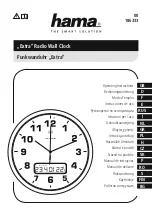
7
PC Programming Definitions
Audio:
Programming screen where you can Upload, Download, Erase, Set volume and message start delay for the wave
files stored in the
CTG-2A
.
Calendar:
Opens the PC programming screen “Calendar” where you can select which schedule you would like the
CTG-
2A
to run on which days during the year.
Cal Err:
“Cal”, “Err” will flash on the clock display any time the
CTG-2A
has lost power long enough to deplete its internal
capacitor clock back up (approximately 4 days) and has one or more programmed events with specific dates or daylight
savings time programmed. This can be corrected with a “Forced Time Sync” (see page 18) or enter PC programming and
re-program the clock in the “Clock” screen (see page 15).
Clear Com:
If you are experiencing multiple error messages while manipulating features in the “Audio” screen, select “Clear
Com” and reattempt the previous programming causing the error. If this does not clear the errors, we recommend closing
and reopening the program,
Conflicts:
PC programming screen where you can have the software review the programmed Events and Schedule changes
in your dat file to determine date or time conflicts.
Dat File:
PC data file for storing CTG-2A programming data.
DHCP:
Dynamic Host Configuration Protocol. It is used to automatically configure the network setting. In this procedure
the network server or router takes note of a client’s MAC address and assigns an IP address to allow the client to
communicate with other devices on the network.
Diagnostics:
This is for use by qualified Viking Technical support personnel to view firmware memory, factory clock
calibration, etc.
Download:
Downloads internal programming data from the
CTG-2A
to the PC screen you have open.
Event Programming Screen:
PC programming screen where you enter/program individual events to activate at specific
times during the day, week or on specific dates.
Help File:
Selecting the “Help” pull down menu and clicking on “Instructions” will open the “CTG-2A Help File”. Open this
file for detailed instructions on PC programming of the
CTG-2A
.
MAC Address:
MAC stands for Media Access Control. A MAC address, also called a hardware address or physical address,
is a unique address assigned to a device at the factory. It resides in the device’s memory and is used by routers to send
network traffic to the correct IP address. You can find the MAC address of your
CTG-2A
printed on a white label on the top
surface of the network port.
NTP:
“NTP” is the abbreviation for “Network Time Protocol”. It allows computers to synchronize time over the internet or a
local network.
NTP server:
The time server the
CTG-2A
should use for time syncing. It can be a local server or a server on the internet.
The factory default time server is “0.viking.pool.ntp.org”.
NTP Sync:
Clicking NTP Sync will activate a forced Network Clock Sync and download the current time and date. This
process will take approximately 6 seconds. The current time and date will then be loaded into the
CTG-2A
and displayed
under “Clock Time”.
Note:
Unit must have internet access or be programmed for a local time server for NTP Sync.
Off Mode:
The
CTG-2A
can be placed in the “OFF” mode via push button, PC or touch tone programming. In the “Off”
mode the unit will not play or activate any programming events. The unit will keep time and the 4 trigger inputs will remain
functional. Unlike the “dS” (system disable) mode, in which the unit can automatically enable its self on a programmed time
or date, when the unit displays “OFF” it can only be taken out of the “Off” mode manually via push button or PC programming.
Print and Print Data:
Print simply prints the current screen you are working with. Print Data prints the entire Event
Programming Database in a “printer friendly” format.
Save:
Saves changes to the current open screen, to the PC dat file.
Snc Err:
“Snc”, “Err” will flash on the clock display when the
CTG-2A
is unable to synchronize with the network. If this
happens, check to make sure the
CTG-2A
has a network connection and that UDP port 123 is not blocked by your company’s
firewall. Then go into PC programming under “Set Up Clock” and verify the correct time server is configured.
System Disable:
This task allows you to program a specific date and/or time to disable all timed events. This is useful in
schools for disabling all events during spring break, holidays, etc. Triggered inputs 1-4 will remain functional during “System
Disable” times.






































